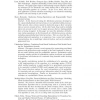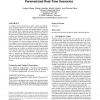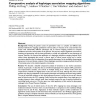122 search results - page 20 / 25 » Structure in Errors: A Case Study in Fingerprint Verificatio... |
SIGSOFT
2008
ACM
14 years 8 months ago
2008
ACM
Software fails and fixing it is expensive. Research in failure prediction has been highly successful at modeling software failures. Few models, however, consider the key cause of ...
CORR
2009
Springer
13 years 5 months ago
2009
Springer
Abstract. We apply Uppaal Tiga to automatically compute adaptive scheduling strategies for an industrial case study dealing with a state-of-the-art image processing pipeline of a p...
SCESM
2006
ACM
14 years 1 months ago
2006
ACM
As technical systems keep growing more complex and sophisticated, designing software for the safety-critical coordination between their components becomes increasingly difficult....
BMCBI
2006
13 years 7 months ago
2006
Background: Finding the genetic causes of quantitative traits is a complex and difficult task. Classical methods for mapping quantitative trail loci (QTL) in miceuse an F2 cross b...
BCS
2008
13 years 9 months ago
2008
Programs are fragile for many reasons, including software errors, partial failures, and network problems. One way to make software more robust is to design it from the start as a ...



